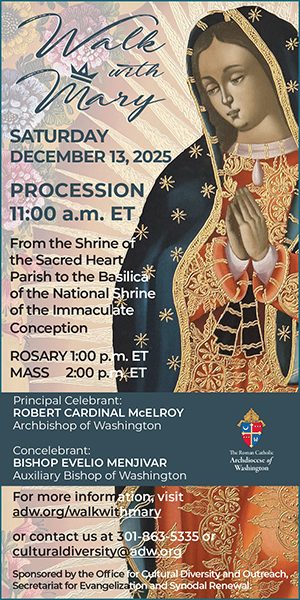At the Saint John Paul II National Shrine in Washington, Dr. Mary Soha, vice postulator for the Cause of the Martyrs of La Florida, offered a detailed look at the 58 individuals whose deaths between 1549 and 1715 are now under consideration for sainthood. The presentation, titled “The Martyrs of La Florida: Lessons on the New Evangelization,” explored the early Catholic mission system established in the region the Spanish called La Florida, which at the time covered territory well beyond the present state of Florida.
At the start of the program, Washington Auxiliary Bishop Evelio Menjivar welcomed attendees and reflected on the significance of remembering the martyrs during Native American Heritage Month. He noted the long tradition within the Church of honoring those who gave their lives for the faith and said the witness of the martyrs of La Florida shows how Indigenous and Christian heritage “intertwined” in the region’s early Catholic communities. Bishop Menjivar also led those gathered in prayer, asking God to help the Church continue the work of reconciliation and to honor the stories and faith of Native Americans.
The cause, formally titled “Antonio Inija and Companions,” was submitted to the Vatican in November 2023. It includes men, women, children and one unborn child, and spans 14 distinct martyrdom events linked to Dominican, Jesuit, Franciscan, Spanish, Creole and Indigenous members of mission communities.
Dr. Soha told attendees that she approaches history as a storyteller, emphasizing what she described as the “salvation story of humanity” rather than speculation about what might have happened. She said that the history of La Florida cannot be understood without recognizing the efforts of early Catholic missionaries who advocated for Indigenous dignity and a non-coercive approach to evangelization.
She highlighted the work of Dominican friars Bartolomé de las Casas and Luis de Cáncer, who opposed the abuses taking place in the Caribbean and parts of Central and South America and urged a model of evangelization centered on respect, cultural understanding and freedom. Their advocacy contributed to the 1537 papal documents of Pope Paul III affirming that Indigenous peoples could not be enslaved and were fully capable of receiving the faith. In 1542, King Charles V enacted reforms known as the New Laws, which restricted military expeditions in La Florida until missionaries had first offered instruction in the Catholic faith.
The first martyrdom in the cause is Father Luis de Cáncer, who was killed on June 26, 1549 at Tampa Bay shortly after he began evangelization efforts on Florida’s west coast. Jesuit missionaries later entered La Florida, and eight Jesuits were martyred in present-day Virginia in February 1571. The Franciscans followed, and by the early seventeenth century had begun extensive mission work among the Apalachee and other Indigenous nations.
Dr. Soha explained that, according to both historical documents and archaeological studies, these missions were Indigenous communities centered on the Eucharist, where Native American Catholics built their own chapels, served as catechists and sacristans and maintained village life around the presence of Christ in the tabernacle. She noted that the mission system grew to include more than one hundred communities across what are now Florida, Georgia and parts of Alabama.
Much of the violence associated with the martyrdoms occurred in the early 18th century, when British colonial forces and their Creek allies launched raids into mission territory. One of the most documented events occurred on Jan. 26, 1704, during an attack on the mission of Ayubale. Antonio Inija, an Apalachee leader, catechist and skilled carpenter, was captured along with other mission members. Eyewitness testimonies preserved in the cause describe his refusal to renounce his Catholic faith and his encouragement to other captives to remain steadfast.
Also included in the cause is Don Patricio de Hinachuba, the principal chief of the Apalachee. Dr. Soha said Don Patricio corresponded directly with the Spanish crown, advocated for the well-being of his people and defended Catholic mission communities during the British attacks. He was captured and killed in 1706 after refusing to abandon the faith.
Throughout the presentation, Dr. Soha addressed the challenges of reconstructing this history. When Spain ceded Florida to Britain in 1763, she said, most original documents were taken to archives in Spain and Mexico, and others were seized during British incursions. Renewed interest in this history began in 2007 when a group of Catholic homeschooling families in Tallahassee organized the first Florida Catholic History Conference, which led to the formal opening of the cause.
Researchers have since uncovered documents in Spanish, Mexican and English archives that describe mission life and provide names, dates and testimonies about the martyrs. Dr. Soha said new findings also include evidence that some Apalachee descendants resettled in Louisiana, where community members have preserved aspects of their Catholic heritage.
Audience members asked how to learn more, how to teach this history and how to present it accurately in conversation. Dr. Soha encouraged attendees to use the cause’s website, martyrsoflafloridamissions.org, which includes biographies, timelines, educational material and a prayer for beatification.
She also encouraged Catholics to adopt one of the martyrs for personal prayer or study. “The importance of their story is not how they died, but how they lived,” she said. “They received the Catholic faith, they defended it and they lived it with courage.”
The talk was sponsored by the Saint John Paul II National Shrine with support from the Roman Catholic Archdiocese of Washington’s Office of Cultural Diversity and Outreach.















